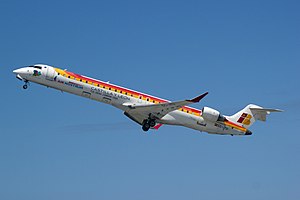CRJ 700
| CRJ700 series CRJ700, CRJ900, and CRJ1000 |
|
|---|---|
 |
|
| Air Nostrum CRJ900 in 2014 | |
| Role | Regional jet |
| National origin | Canada |
| Manufacturer | Bombardier Aerospace |
| First flight | 27 May 1999 |
| Introduction | 2001 |
| Status | In service |
| Primary users |
SkyWest Airlines PSA Airlines Endeavor Air Mesa Airlines |
| Produced | 1999–present |
| Number built | 811 as of June 2017 |
| Unit cost | |
| Developed from | Bombardier CRJ200 |
The Bombardier CRJ700, CRJ900, and CRJ1000 are regional airliners manufactured by Bombardier and based on the CRJ200.
Following the success of the CRJ100/200 series, Bombardier Aerospace produced larger variants in order to compete with larger regional aircraft such as the Fokker 70/Fokker 100 or the BAe 146 family, and competed later with the Embraer E-Jet family. It accounts for over 20% of all jet departures in North America and globally the family operates more than 200,000 flights per month: a CRJ takes off every 10 seconds.
Final assembly of the aircraft is at Montréal-Mirabel International Airport in Mirabel, Quebec, outside Montreal, Quebec, Canada.
In 2007, Bombardier launched the CRJ900 NextGen to replace the initial version. Its improvements and conic nozzle enhances fuel economy by 5.5%. The new model has improved economics and a new cabin common to the CRJ700 NextGen and CRJ1000 NextGen. Mesaba Aviation, operating at the time as Northwest Airlink (now Delta Connection), was the launch customer, and remains the largest operator of the CRJ900 NextGen. The Mesaba fleet of CRJ900 NextGen aircraft are configured in a two class seating configuration, with 12 first class seats and 64 coach seats.
In 2008, the CRJ700 was replaced with the CRJ700 NextGen, featuring improved economics and a revised cabin common to the CRJ900 NextGen and CRJ1000 NextGen. In January 2011, SkyWest Airlines ordered four CRJ700 NextGen aircraft.
In 2016, Bombardier began offering a modernized cabin design for the CRJ Series with a more spacious entry, larger overhead bins, larger windows, newer seats, larger lavatories, and upgraded lighting.Maintenance intervals were extended to 800/8,000 hours.
...
Wikipedia
